#its based off of her suits from the comics. obviously. like very heavily.
Text
My Cassie suit design thing

#its based off of her suits from the comics. obviously. like very heavily.#It's just the slight tweak of how it'll look in my MRU#mru#mcu#mcu rewrite#marvel#young avengers#cassie lang#marvel rewrite universe#marvel cinematic universe
9 notes
·
View notes
Link
An old saying goes that a hero is only as good as their villain, but in the realm of horror, the villain tends to overshadow the hero. This isn't the case quite as much in horror video games, as both heroes and villains can truly manage to be equally as appealing.
RELATED: 10 Scariest Games You Can Play On Switch Right Now
With all that being said, sometimes really good villains from the realm of horror games tend to get overlooked, with there being a cornucopia of excellent examples. In fact, some of them are so sinister, they have somehow managed to overshadow literal demons with their particular brand of villainy.
10 Calypso (Twisted Metal: Black)
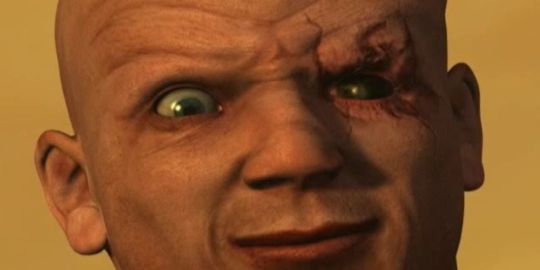
Out of all these games, Twisted Metal: Black is the least strict in terms of horror, but it manages to be scarier than most traditional horror games. Unlike the previous games, where Calypso was a flamboyant character who spoke eloquently, Calypso is silent in Black, with a design more in line with the game's less comical tone.
Portrayed as a creepy, hairless man with a black glass eye who sits upon a throne of damaged cars, Calypso is a bit fairer in this game, but very rarely do the competitors of the Twisted Metal competition get what they want when they approach him. In fact, the only person who can truly defeat him is someone far eviler than he is.
9 Betruger (Doom 3)
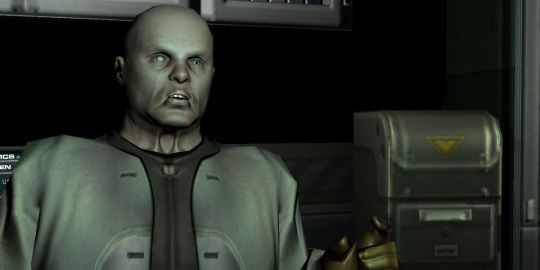
Speaking of bald men with unique eyes, Doom 3's Malcolm Betruger is so creepy he manages to outdo actual demons. The head of the research division on the UAC's Mars Base, Betruger's unorthodox experiments causes his subordinates to be scared of him, which leads to the UAC stepping in and investigating his activity.
It's revealed that Betruger opened up a portal to Hell, leading to an armada of demons taking over the base, with only the infamous Doom Guy being able to stop them. Throughout the game, Betruger taunts Doom Guy, which ends when the villain is turned into a winged demon known as the Maledict, which leads to a terrifying boss fight.
8 Wendy (Rule Of Rose)

If the game played out like the fairy tales that inspired it, perhaps Rule of Rose would see Wendy and main character Jennifer living happily ever after, but that isn't the case. The founder of The Red Crayon Aristocrat Club, Wendy soon befriends Jennifer and the two fall in love.
RELATED: 10 Horror Games That Would Make Amazing TV Shows
Unfortunately, this love story ends in tragedy, as Wendy becomes jealous when Jennifer shows more affection towards her new dog Brown, so she orchestrates events that lead to Brown being beaten to death. What follows is a series of events that lead to Wendy, along with the rest of The Aristocrat Club, being brutally murdered and Jennifer being left all alone.
7 Lionel Starkweather (Manhunt)
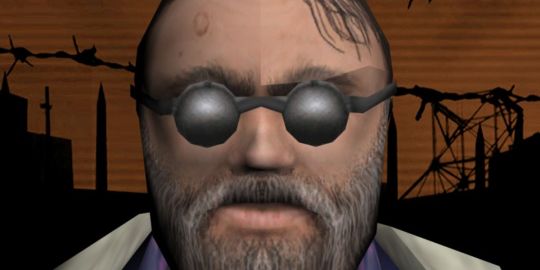
Voiced by the legendary Brian Cox, Lionel Starkweather was once a prominent filmmaker, but a series of flops sent him down a path that led to him making elaborate snuff films. In Manhunt, Starkweather frees convicted murderer James Earl Cash to make him the star of his latest vile venture.
After slaughtering gangsters, hate group members, deranged psychopaths, and a deranged man in a pig suit, Cash murders his way through Starkweather's empire before slicing his head off with a chainsaw. It goes without saying that Starkweather succeeded in making Cash an even colder killer, but he may have done so a bit too well.
6 Walter Sullivan (Silent Hill 4: The Room)

The town of Silent Hill is a scary enough villain as it is, so that should make the idea of any of the games having a true villain almost perfunctory. Regardless, the divisive fourth entry proves that it can be done with serial killer Walter Sullivan.
A murderous religious zealot who feels that it is his mission to murder 21 people in order to complete the "21 Sacraments," Walter Sullivan is a terrifying presence throughout the game. What makes him scarier is how his victims become horrifying monsters that will haunt the dreams of many players.
5 The Xenomorph (Alien: Isolation)

A masterclass in terror, it seems as if Creative Assembly's Alien: Isolation has been somewhat forgotten about. This is a shame, especially since the game recaptured the terror of the original film from 1979, with the Xenomorph being more terrifying than ever. After years of being a bit of a joke, Isolation's portrayal of the creature that laid siege to The Nostromo was a shot in the arm.
RELATED: Alien Isolation: 5 Reasons It's The Perfect Alien Sequel (& 5 Where It Falls Short)
What makes this version of the Xenomorph so terrifying is that its AI is near-perfect and it can show up at any time, attacking Ellen Ripley's daughter Amanda from out of nowhere. The Xenomorph isn't the only antagonist in the game, but it is certainly the scariest.
4 SHODAN (System Shock 2)

As time has gone by, SHODAN, the main villain of the underappreciated System Shock series, has received a cult following in her own right. While her presence in the first game is memorable, it's the more horror-centric sequel System Shock 2 that gives SHODAN her time to shine.
When the military spaceship Von Braun becomes overrun by an infection that turns the crew into The Many, a survivor named Polito leads an unnamed, amnesia-stricken soldier throughout the madness. Obviously, SHODAN is involved, with her reveal coming in one of the most shocking moments in gaming history.
3 Daniella (Haunting Ground)
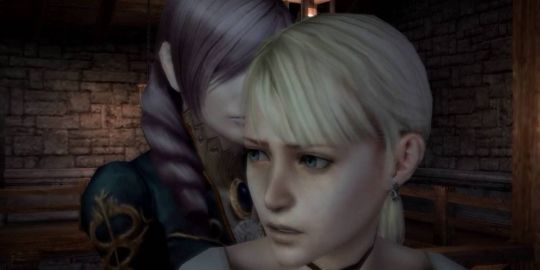
Haunting Ground is one of the most disturbing games ever made, with the game dealing with heavy themes including voyeurism and incest, which are themes that will get under most players' skin. Of the four villains in the game, Daniella is the most chilling, with her inhuman perfection making her highly creepy.
On the surface, Daniella, the maid of the castle that Fiona, the main heroine, is trapped in, seems like a perfect human being. However, this comes at the cost of being able to feel or enjoy anything, causing her to lash out towards Fiona out of jealousy.
2 Scissorman (Clock Tower)
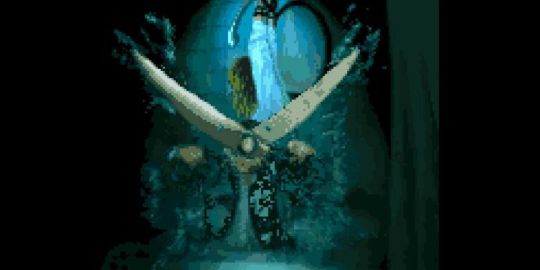
Scissorman, the main villain from the first two Clock Tower games is uniquely terrifying. A persona attributed to the demonic Barrows brothers, the killer that made his debut in a Japanese-exclusive SNES game called Clock Tower, is heavily reminiscent of slasher villains, such as Jason Voorhees and Michael Myers.
RELATED: Clock Tower & 9 Other Forgotten Video Games That Would Make Great Movies
Much like the Xenomorph from Alien: Isolation, Scissorman will appear randomly and can attack the main character, Jennifer Simpson, at any point. Both incarnations of Scissorman take sadistic pleasure in murdering people, which gives them a terrifying prescience that makes up for their small size.
1 AM (I Have No Mouth, And I Must Scream)

Based on the novella written by Harlan Ellison, I Have No Mouth, and I Must Scream is a well-crafted reimagining of a rather dour story. AM, who is actually voiced by Ellison, is a supercomputer created by America, Russia, and China which gained sentience and destroyed all life on Earth, killing everyone, save for five unfortunate souls.
AM, being particularly cruel, made these people invincible and tortured them for 109 years before putting them into a terrifying game. Placing each person in their own scenario that calls upon their distinctive failings, AM is a haunting vision of what the state of the world could turn out to be.
NEXT: 10 Best Vampire Video Games To Sink Your Teeth Into
10 Most Underrated Horror Game Villains, Ranked | ScreenRant from https://ift.tt/2QQt4yi
2 notes
·
View notes
Note
Hello, I love your lucifer thoughts, and if you want to write it I would love to now your thoughts on lucifer using names/nicknames
I’ve thought about this a lot. I even touched on my personal headcanon about it in the last chapter of Taking the Fall :)
Obviously, Lucifer uses nicknames or alternative names a lot. I think he says the word “Chloe” less than a dozen times across three seasons, while he uses “Detective” or “the Detective” hundreds. She’s even saved as “the Detective” in his phone.
So, let’s start at the beginning. (In the beginning...) The show has drawn from many sources to construct Lucifer Morningstar as we know him. Obviously, we’ve got the comics. Personally, I see a bit more of Neil Gaiman’s Lucifer than Mike Carey’s (and, to be completely honest, I feel like a bit of Gaiman’s Crowley may be mixed in there as well). In Carey’s comics, Lucifer is much more able to think in the Very Long Term, for example, and is essentially always acting on a Plan of his own (which creates a neat parallel between God and Lucifer, but I digress). Gaiman’s Lucifer is the one who is Done with Hell and basically hands over the keys; he’s also the one who cuts off his wings; he’s the one who speaks the great lines the show used to such effect--about not being responsible for humanity’s sins and disliking that he’s blamed for things he’s not responsible for. He’s also the one who retires to LA, starts a nightclub called Lux, and really has a thing for sunsets. Gaiman was also the one who established that Lucifer was once called Samael. Gaiman’s Lucifer is heavily influenced by Milton’s Paradise Lost iteration of Lucifer (he of “It’s better to reign in Hell than serve in Heaven” fame; Milton’s Lucifer gets all the best lines). He’s not distinctly (or solely) comprised of Christian or Jewish mythologies, though both influence the character.
In his short story, “Murder Mysteries,” (which features the same Lucifer he incorporated into the Sandman comics) Gaiman establishes at length how angels are named. First, they include “el”, which means, “of God.” The other part of their name indicates their purpose. Samael, depending on the translation, can mean venom, poison, or blindness of God. I don’t know about you, but if my name was Poison, I’d probably feel like I got the short end of the naming stick. This is contrasted, of course, by the same angel carrying the name (or perhaps title), Lucifer. When Gaiman introduces him, it’s by another character saying, “He was the Creator's finest creation: the angel Samael, called Lucifer. It means ‘the bringer of light.’ Of all the angels he was the wisest, the most beautiful, the most powerful. Saving only his Creator, he is, perhaps, the most powerful being there is.”
When Lucifer Fell, he abandoned the name Samael. He rejected it. Poison or not, he was no longer “of God.” Whether out of spite or anger or truth, Lucifer rejects the name his Father gave him in favor of the title. He identifies himself as Bringer of Light; this is the name he chooses. In the show, we witness Lucifer’s reaction to Samael when Linda speaks it. It angers him. Upsets him. After all this time, he is not indifferent to it. And though he claims not to care about many things related to his past, the name is very obviously a match to very dry tinder.
Names, to Lucifer, mean something beyond just monikers to identify one individual instead of another. Names having power is pretty common in mythology. The show also indicates that angels, specifically, can be summoned by prayer--presumably invoking their names with intention; Lucifer summons both Amenadiel and Uriel this way. It’s unknown whether Lucifer can still be summoned (or hear) prayers. It’s also unknown whether that prayer would have to be directed at his of-God angel name; still, I think there are many reasons why Lucifer holds names at arm’s length.
Names are also intimate; knowing them and using them can indicate deeper relationships, connections. Even with all the growth we’ve seen in Lucifer, he is still leery (if not afraid, though he’d never put it that way) of intimacy, friendship, connection. Lucifer has, for almost the entirety of his existence, been alone. Even when he wasn’t physically alone, his relationships have been marked by power imbalances. In Heaven, he was “of God”--created for a purpose and pretty unrepentantly “part of God’s plan.” In Hell, he was Lord and Master; Maze is/was the closest thing he had to a friend, and we continue to see how unbalanced that relationship was. You can’t truly be friends with someone when you see them as an underling, an employee, as belonging to you in a manner that implies use.
This question of usefulness is a huge one, and probably deserving of its own meta, but since it also comes back to names, I’ll touch on it quickly: Again, from the beginning of his existence, Lucifer has existed to be of use--first, as God’s brightest angel; then, as Lord of Hell. This notion of usefulness as balance or quid pro quo is woven so intrinsically into Lucifer’s understanding of himself that it very nearly becomes his definition. Balance, justice, an eye for an eye--all of these things are irrevocably part of the fabric of Lucifer. When he desires something, he doesn’t just take; he trades. To be certain the trade is equal, he asks what the subject of his desire desires, essentially asking, “What can I give you that’s equal to what I wish to take from you?” It’s also the basis of his favors: “If I do this for you, you owe me in equal measure; this is non-negotiable.”
Because Samael was, in his mind, treated unfairly, Lucifer (light-bringer meaning both physical light and the light of truth) has unbreakable codes of fairness. They may not always look like a human understanding of fairness, but Lucifer’s internal morality (ironically) is pretty sacrosanct. Essentially, he may be judge and jury and punisher, but he does make sure the trial is fair. In Sandman, Hell builds itself around Lucifer. This may not be explicitly stated on the show, but the notion of hell-loops and guilt and punishment equaling the crime are all very Luciferian. Did Hell alter itself to suit his sense of justice? Or did Hell’s justice affect Lucifer? (Given that we do know at least a little about pre-Hell Samael/Lucifer, I think it’s more the former.)
So, nicknames. Lucifer uses positive nicknames and negative ones. The tone is important. Brother can be scornful, angry, frustrated, almost spiteful. And sometimes, especially as Lucifer and Amenadiel’s relationship changes over time, it can be genuine and even grateful. Brother/sister/Mum are actually really important, I think. These are family relationships that have been all but severed for an unfathomable amount of time, but Lucifer still uses them (and not always sarcastically or with derision). Tellingly, his family still uses brother/son with him, as well. Lucifer still wants connection, but he no longer trusts it; it can be taken from him. Using nicknames/epithets is a way to keep people at a distance--he makes them their job, their position (the Detective, obviously, but also Dr. Linda); in some cases, he keeps things formal (Ms. Lopez); in others, the nickname is openly scornful (Detective Douche; sneering Cain--the secret name; the murderer’s name--instead of using Pierce).
Lucifer diminutizes names when he’s lording over people or displaying superiority (Pierce becomes Piercy; Reece becomes Reecy. Reece actually has a bunch of nicknames, and you can always tell how Lucifer feels about the guy at any given moment based on how he refers to him). He calls criminals by their crimes (“Hello, murderer.”), relegating them to their crimes, their sins, their actions, and taking away the humanity of a name full-stop. Sometimes Lucifer’s nicknames are tools, sometimes they’re weapons; I think sometimes they’re even gifts, or at least an attempt to create a connection even though the most intimate or closest avenue (just using their name) is still too much for him (Dr. Linda is not the very formal Dr. Martin; Ms. Lopez is very occasionally ‘dear Ella’; he uses darling, love, lovely a lot--mostly positive, but again, tone is a factor. I’d hate to be on the wrong end of a scornful or hateful darling).
Also related to power/superiority is his insistence that people use his name--the name he chose, that he adopted. Ella swiftly changes Luce to Lucifer. Similarly, he is very open about the identity he adopted--the Devil. When things arise to question that identity or poke at it too hard, he becomes unsettled, even untethered. The wings/devil face of S3 was all about this notion of forced rather than chosen identity (at least as he saw it).
Though he is initially scornful, however, he does let his family use nicknames--again, I think that’s part of some long-buried part of him that wants to belong but just does not want to belong as Samael (that is, on his father’s terms). So, Amenadiel calls him Luci. Azrael calls him Lu. Neither gets the violent, visceral response of Linda’s Samael.
Obviously, a whole separate essay could be written on Lucifer’s use (and not use) of Chloe/the Detective. He uses her name when he’s at his most desperate and his happiest. He uses her name, in short, when he’s at his most vulnerable. Sometimes, he’s accepting of this vulnerability (when he’s praying to his father) and sometimes, I don’t think he realizes how vulnerable he is (when he’s just announced to Maze and Mum that he and Chloe are real). In essence, he treats her name as something near-holy, almost sacred. She holds power over him, whether he’s conscious of it or not; her immunity to his power is part of it--she is, in essence, unknowable because he cannot fall back on the familiar to understand her. His feelings for her, obviously, are another part of it; this is a very particular and uncomfortable kind of vulnerability that he both craves and is terrified of (caring about something that much means it can hurt you, and the last time he cared, he was hurt beyond all belief--and certainly, in his mind, in a manner committed the unforgivable crime of being unjust).
So, after all this discussion, I think the takeaway is that Lucifer uses nicknames as weapons to wield or consolidate power, shields to keep himself at a distance and defend himself from hurt, jokes to deflect, arrows to wound (and, ironically, usually those harsh nicknames are poison-tipped). And all of this is rooted in his own very complicated history with names--and with how names have been used to influence him or inflict pain, especially concerning power/powerlessness, control, and choice.
#lucifer on netflix#lucifer morningstar#lucifer meta#lucifer thoughts#lucifer analysis#asks and answers#Anonymous#long text post#if brevity is the soul of wit i'm doomed#i could've gone on for fifty more pages
226 notes
·
View notes
Text
SO LET’S TALK “WHO’S THE TRAITOR” SOME MORE

If you’ve never read my initial theory post, please do yourself a favor and check that shit out. It is a foundation for the theory that, regrettably, was missing a lot of information that I wasn’t able to get to until I was able to do a reread of the series, plus I wanted to wait for the series to develop a little further. The original post was made right after "Deku vs Kacchan 2" was released, so we’ve had about 30 chapters of development. You might be wondering how on earth 3k words isn’t enough to make my point the first time, but here I am yet again!
I might sound crazy, but believe me when I say… I am the MOST serious.
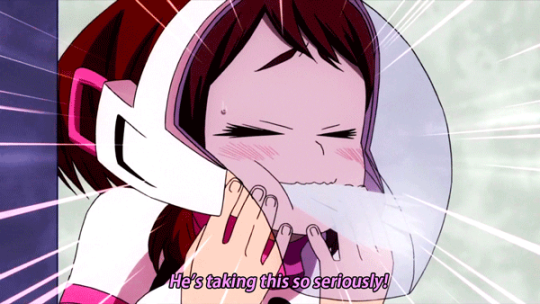

The Art of Subtlety
One of the most amazing things about Horikoshi’s writing is that he is incredibly subtle. This has happened in a bazillion different places, from pointless comparisons like Horikoshi’s love of rabbits, the rabbit-like ears on Deku’s costume, and the antenna that the rabbit-ears are meant to emulate; and it can also span a much greater distance, the subtle references to Bakugou’s issues with Deku mentioned in their first fight, later making more sense in their second. Uraraka is no different. Without going into anything about traitors yet, here’s an example. Most of us might say that the very first time that Uraraka’s crush on Midoriya comes up is when Aoyama asks her about it during the midterm exam. But actually, it’s Gunhead who first teases her about it right after the Hero Killer Stain arc!
More significant moments have happened, as well. I’d like to talk two kinds of subtlety; artistic subtlety and literary subtlety. Because we’re dealing with a comic book, both art and literature ideas should be taken into account, though naturally they have expectable overlap. The following image is the entire basis for the theory that there is actually a second Twice that exists in canon right now.
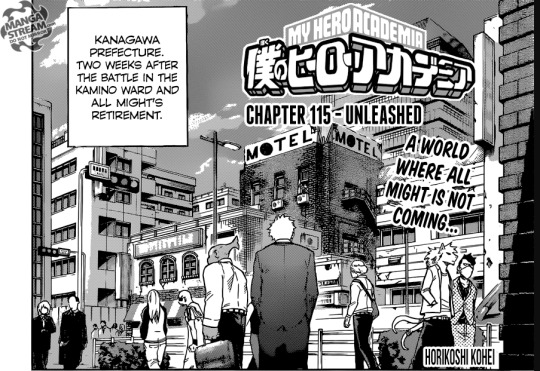
Middle guy look familiar? This kind of subtlety relies a bit on artistic judgement. The figure’s hair is a light object on a dark ground, is located in the very center of the image, is the foremost, unobstructed figure in the picture, and it is the largest unobstructed figure on the page. The gradient on his suit could also be a way to guide the viewer up to the characters head. He is also located under the window which, presumably, Twice is looking out of as he tells his story. This is all a part of “artistic subtlety”, where even though we’re given no words regarding the situation, the art draws our attention to the character in the center. This, naturally, hasn’t been proven yet, but I’m sure in due time we’ll see it bears fruit.
Toga’s quirk also gets concealed by subtleties, though this time we must infer by what is written. Upon being introduced to Toga, we never find out what her quirk is. Despite this, it later becomes hinted at during her encounter with Uraraka: "You wanna be the same as the guy you like, it's only natural! so you, like, wear all of the same things! // But then you start not taking the same satisfaction as before and you start wantin' to straight up become that person! There's just no helpin' it!" (FA translation, image linked below.)
It’s subtle, but unmistakably a reference to what we would eventually find out. It’s only later on that Toga actually uses her quirk, becoming Camie - but again, we have no reason to believe that Camie could be an imposter. Nevermind the fact that Camie, for some reason, is WEIRDLY obsessed with Midoriya upon meeting him without knowing anything about him (couch, Toga’s crush on Midoriya). The other thing that I’d like to note is that Camie expresses an odd interest in Uraraka when she disappears, obviously a result of their first encounter:

All of this is enough to give the suggestion that Camie is actually Toga, and I don’t think it would have been farfetched in previous months to have made this theory. Horikoshi definitely deals heavily in subtlety.
So, this might sound like a lot of talk about Not Uraraka, but hear me out. What’s important to note here is just that the subtlety is the basis of the argument - because that’s just how Horikoshi writes. What I’ll be doing here mostly is connecting her to other things in the series, and how what we’ve seen compares to Uraraka’s behavior. Even I’ve made a subtle remark already toward a later part of the theory.

Double Double, Toil & Trouble
This first one is a bit silly, but I think it’s kind of funny and curious; and also I want to make a point about "artistic subtlety.” If you take a look at the 2017 character poll for My Hero Academia, you’ll find that the characters in the image appropriately line up with the kind of role they would play in a medieval fantasy RPG. Bakugou the rogue barbarian, Deku the commoner, Iida the knight, and Todoroki the nobel they fit because of who they are in canon. Though were forced to speculate a little, we cannot doubt that each of these characters absolutely fits their role.
Then…. we get to Uraraka. The witch. Though it’s absolutely possible to claim she’s "just a mage," we should be particular about the artistic decisions made when designing her costume. The pointed cap, the rustic color scheme, the wooden staff - from experience dealing with RPGs, that usually adds up to a "black mage," which of the different types of mages most closely equates "witch." There is variation, but could Uraraka be any other kind of mage base on her costume?

What’s in a Name?
Horikoshi has been fairly intentional with his naming structures, as is typical of manga and anime. This is a part of literary subtlety, similar to the queues Toga has given to her quirk and Camie’s true identity.
Just some examples of current naming sturctures: Midoriya contains the kanji 緑 (midori), which is "green" in Japanese. Bakugou’s name uses 爆 (baku), a part of the word 爆破 (bakuha), meaning "explosion." We even see characters developing naming structures in canon; Bakugou changed the meaning of “出久”, Izuku, to “Deku” - and also in the way Uraraka reappropriates the name. There’s a lot of hidden meaning and puns involved with the names in MHA. So…
We know Urarka Ochako’s name, 麗日お茶子, means "bright, beautiful" and "tea girl" respectively. Her hero name is Uravity, ウラビティ, which is again a kind of pun on her name. The two names are meant to be just subtle fun references to her personality and her quirk.
My hang up here is the interesting fact that "ura" is actually a repeating element in both names. I’m thinking of the noun 裏 (ura). I’m just going to list off a few translations using the character on its own as well as a few highlights of how it’s combined with other kanji and hirigana to give you a sense of what kind of word 裏 is.
裏(うら) (ura)
1. bottom (or another side that is hidden from view); undersurface; opposite side; reverse side
4. out of sight; behind the scenes; in the shadows
裏切る(うらぎる)(uragiru)
1. to betray; to turn traitor to; to double-cross
裏方 (うらかた)(urakata)
1. someone working behind-the-scenes; scene shifter
translations: jinsho(.)org
Obviously, 裏 is not in Uraraka’s name, the "ura" instead coming from 麗 (urara), but like… if Horikoshi actually used the other kanji it would have been a dead give and I wouldn’t be here arguing this. Covering up this naming structure seems like just the kind of thing Horikoshi would do. Given that we have uraraka and uravity being repeated as a theme, is it really far off to think perhaps there’s more meaning to it?
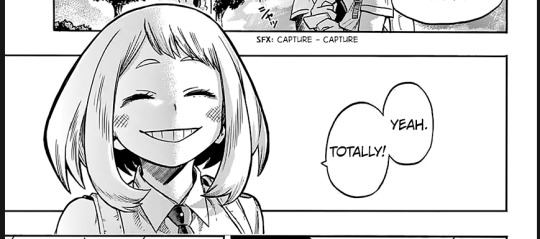
Envy
verb 1. desire to have a quality, possession, or other desirable attribute belonging to (someone else).
As loving and kind as Uraraka is, we cannot forget that she has her flaws just as every character in MHA does, which is what makes her and so many characters in the series so great. What’s interesting, however, is that her flaws (as far as this post is concerned) have a lot to do with a particular theme that keeps repeating in the storyline: the them of admiration, imitation, and copying. Some examples from the heroes include the struggle Midoriya is constantly overcoming to separate himself from his idol, All Might; Iida nearly getting himself killed because his admiration for his brother get over his head; and the struggles Todoroki goes through trying not to become like his father.
The villains are just as much part of this theme; however, it would appear that one of the aspects has consumed them. For example, Twice’s quirk is to make copies, which we’ve seen resulted in the identity crisis he talks about in his monologue. Toga’s ability to imitate a person, and how her own personality results in an obsession with wanting to literally become her crush. All For One is the quirk that pretty much embodies the tragedy, a man who enviously steals all quirks to inflate his own power.
Which brings me to Uraraka, who must overcome an aspect that makes her most like the villains of any other character. Namely, her crush on Midoriya is absolutely now treads on the thin line between admiration and envy.
Toga first introduces us to the idea when she compares herself to Uraraka, talking about how they both want literally to become the person they admire. That admiration is what makes Toga’s personality “evil.” Because Toga relates her own feelings to Uraraka’s, we as the readers are meant to question the approach to Uraraka’s crush in turn. Has she envied Midoriya longer than she’s had feelings for him? Has the number of people asking if she had a crush on Midoriya affected the way she she perceives her own feelings? Did she deceive herself to believe her own envy is actually feelings of love?
Every other hero in the story has been shown exactly why imitation and admiration can be a problem and each has learned from their mistakes in order to embrace their own strengths - Midoriya, Iida, and Todoroki are all learning how to embrace the strengths that were passed on to them. But none of these boys learned this lesson without going through great hardships: Midoriya’s scarred arm is proof enough; Iida watched haplessly as his friends nearly got themselves killed to defend him; and Todoroki was shamed at the sports festival resulting in a spell of dissociation and he was shamed during the provisional license exam. Bakugou goes through something similar, in the shape of jealousy; and Momo as well, envying Todoroki.
Uraraka hasn’t learned her lesson, however. In fact, we’re watching over and over again as Uraraka just barely avoids learning her lesson in order to become stronger. For example, during the provisional license exam, this happens:
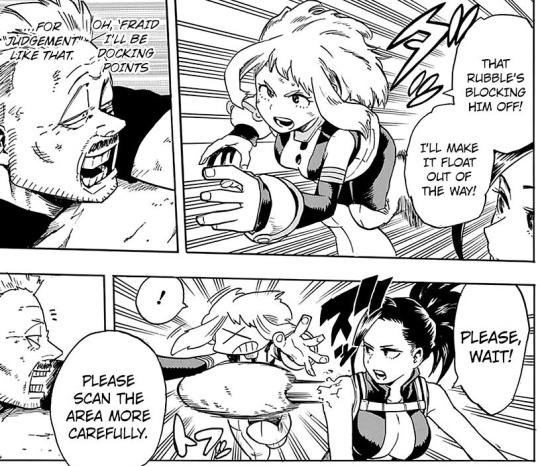
Uraraka reacts this way because she is trying to mimic Midoriya's act-first-think-later attitude, nearly costing her a lot more points during the exam. Instead, Momo cuts her off, thus preventing the much more sever consequences that could have helped Uraraka learn from the situation on her own. Even though she wants to overcome her feelings for Midoriya, she hasn't actually learned anything. She continues to try and become Midoriya, thus inhibiting her own development. And worse, in this case, she's only "learned" because Momo did the thinking for her. Arguably, she would be better off embracing her crush, but Horikoshi just didn’t write it that way.

Chapter Titles and What’s to Come
There are a couple of "themed" chapters in the series, notable by the syntax used in the phrasing of the chapter titles. One is "[Character]: Origin" which Midoriya, Todoroki, and Bakugou have each had. The "origin" chapters are typically a turning point in the title character’s development, and we can assume that this point is the most significant turning point in their storyline. Todoroki uses his fire for the first time; Bakugou works with Midoriya for the first time; Midoriya receives his quirk. Momo also has a similarly phrased chapter for herself, called “Yaoyorozu: Rising,” and she goes through a similar lesson to the aforementioned boys. Logically, Momo is likely to get her own “Origin” chapter later on.
The next is "From [Character A] to [Character B]" which Todoroki, Iida, Midoriya, "teacher" (ie, All Might and AfO), and "disciple" (ie, Shigaraki and Midoriya) are in the the titles. These chapters deal with passing something on. "From Teacher to Desciple" is the (presumed) final battle between All Might and AfO, where at the end of the battle both hero and villain are "defeated" in some way; thus the torch is passed from All Might and AfO to Midoriya and Shigaraki respectively.. Todoroki passes on what he’d learned from the sports fest to Iida; Iida passes on his trust to Midoriya in order to save Bakugou. There’s also "vs" and "and" for a couple themes, but they’re very self-explanatory. Most of these characters have been mentioned a couple of times in the titles of chapters.
Uraraka has only had one of the “themed” chapters with her name in it, titled “Bakugou vs Uraraka.” That is, currently, her pinnacle chapter; almost 100 chapters ago. For the heroine of the story, that is way too long ago. What that means for what we’ve already seen is up to you to decide, but I can say these two things for certain:
As Uraraka continues not to learn from her mistakes, she has no way to grow. She, unfortunately, needs to eat just as much dirt as Midoriya, Bakugou, Todoroki, and Iida have in order for this to happen. So, this much all depends on whether we ever see that chapter appear "From [character] to Uraraka." Similarly, we absolutely are waiting to see the very best of Uraraka, as 100 chapters of going unmentioned in the titles, you better believe that whatever "Uraraka Ochako: Origin" has in store for us is going to be a hell of a trip.

Greed
The other chapter mentioning Uraraka in the title is “That’s the Idea, Ochako,” and the most pertinent panel for us is the one linked above. There's nothing wrong with wanting to do work that you love for money - plenty of people do it, and those people who do work obviously deserve to be paid for their work. There's nothing inherently wrong with Uraraka's way of thinking, and I think it's actually really cool that this is her motive for becoming a hero. I would have no problem with this line ever in a million years! Except for the fact that this gets brought up:

Hero Killer Stain is objectively wrong; utterly and miserably. But this issue was still brought up in canon as something to make us question. There are those who work for a *passion* and those who work for a *paycheck*, and those who work for a passion are, in theory, considered "superior" in their field because they are doing what they love. Whether or not you agree with this mindset is not the issue here; the issue is that this mindset exists, and Horikoshi has consciously brought this mindset into the series. So what does that make Uraraka?
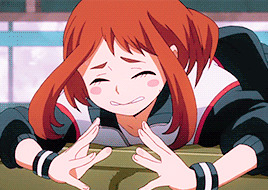
Tactile relationships
It’s probably about time that we start talking about Shigaraki, Overhaul, and Uraraka. You might be asking what on earth these three characters could ever have in common, but as one might have it, their quirks are all surprisingly similar, don’t you think?
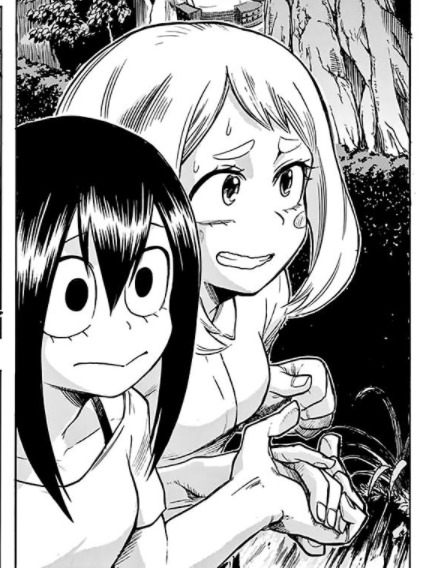
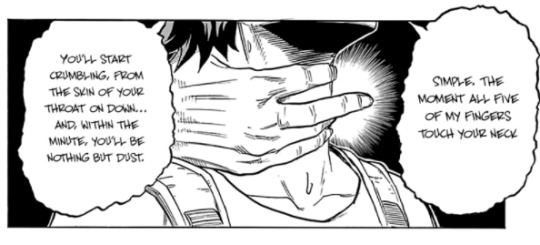
From what we know, all of these characters require touch to make their quirk function. When I initially considered this relationship, we hadn't yet been introduced to Overhaul. I did, however, find it interesting that Uraraka and Shigaraki had such similarly designed quirks, to the point that I have to wonder why Horikoshi allowed them to be as similar as they are. In order for their quirks to take effect, all five fingers must be touching their subject. So, by not touching them with a single finger, as seen above, they keep their quirks at bay entirely.
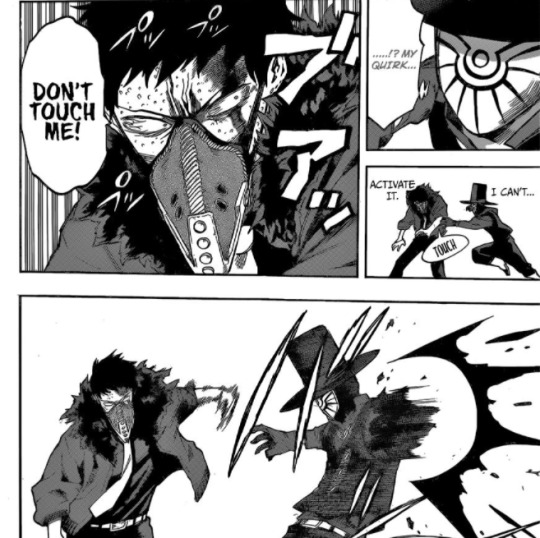
Unfortunately, we don’t know exactly what his quirk is supposed to be, but based on the panel above (and a few other hints in the series) we can assume that touch is part of the requirement, meaning that all three of their quirks are dependent on a tactile relationship. This should be considered different than, say, Mineta, whose balls are always sticky without prerequisites; or Denki, whose quirk can be activated at will when making physical contact. Uraraka, unlike the two villains, can at least deactivate the quirk after the fact.
Tactile relationships appear to be a very important aspect of MHA, which makes this whole theme of quirks so interesting. Although Uraraka might not seem to have a strong, comparable relationship to Overhaul thus making him little more than a prop in this argument, the close, comparable similarities to hers and Shigaraki's quirk is just remarkable enough to make one wonder why Horikoshi, who could have designed their quirks in any way, design these two quirks so similarly.

Uraraka and Toga
Honestly, you should be losing your mind over Uraraka and Toga. THERE’S SO MANY PARALLELS BETWEEN THEM IT HURTS. My deep regret here is just that I’ve said this once before and I’ve read it from others, but still I am unable to stop myself from writing about them. Uraraka and Toga’s relationship is wildly important even if Uraraka isn’t the traitor. I’m losing my mind for the chance that Uraraka and Toga interact again, because I know I’ll need like a year to recover.
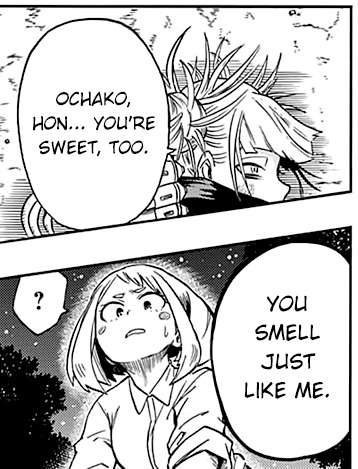
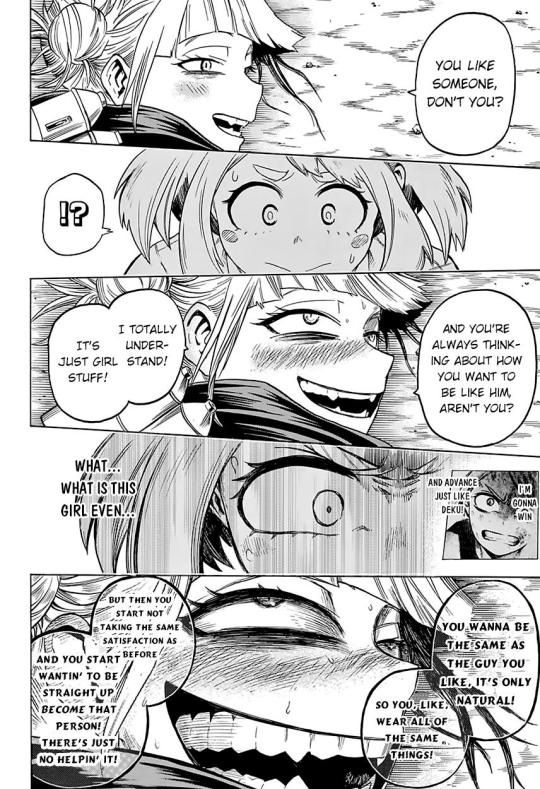
Very quickly into their encounter, Toga immediately likens herself to Uraraka, explaining her own feelings so that we understand who she is. Toga has an unhealthy sense of admiration for the person she also consequently loves. She tells Uraraka this, and Uraraka's reaction is incredible. You know how it goes when someone points out a truth that one has been hiding away? They respond with anger. Not only has Toga made the comparison, but Uraraka seems to understand the truth and validity of her comparison, and for a brief moment we see the frustration build in Uraraka. Her brows are not lifted, but rather they are knitted. Toga has her pegged. Funny to note, after all this, Toga ends up with a crush on Midoriya as well - just one weird similarity between them.
This happens again later on, where Toga literally takes on Uraraka’s person and imitates her during the provisional license exam. This was clearly done as a part of the storytelling mechanic, helping us to understand how well Midoriya knows Uraraka, and also to lead us into the discovery that Uraraka is Camie who, in turn, is Toga; but there is absolutely more to it. Why did Horikoshi decide that Uraraka’s blood should be taken and not, say, Asui’s, who was just as exposed as Uraraka was during their first encounter with Toga. The decision was clearly very intentional, as could be inferred from the manga cover I linked above - Uraraka and Toga/Camie are shown on parallel sides of the cover, and feature as the secondary “center” of the book cover. Uraraka and Toga are connected; their stories are going to connect again, perhaps very soon.
What is our heroine up to today?
To start this section out, because I know I’m going to sound like I’m speaking the contrary: Uraraka is the heroine. In no way shape or form am I denying this, nor do I dislike that she is the heroine. Even if Uraraka turns out to be the traitor, she can still be our "heroine," it’s just super fucked up and probably cooler that way. She’s our heroine because of all the girls, she has the best relationship to Deku, naturally, and she’s also got a ton of excellent relationships with many of the other characters, such as Bakugou, Iida, Asui, and Toga. Add who you like to that list, the relationship she has with pretty much all the characters is great.
However… I find a particular "lack" of our heroine in the story. I’ve briefly touched on this before, as I mentioned that Horikoshi seems to absolutely ADORE female characters (I mentioned how populated his pixiv is with strong, female characters), so the lack of Uraraka is strange. She hasn’t been on the cover yet, she hasn’t gotten her own specialty arc yet - mainly she gets a highlight ever few chapters because she rightfully deserves it. She also seems to fall into the background during critical portions of the series. In fact, I would say her most critical moment in the series was her fight against Bakugou during the sports fest, and since then a lot more has been brooding around her than anything.
"Hold up! Uraraka has been doing a lot! She got an internship right now and everything!" Like, right??? It’s amazing! But like…. We totally didn’t get to see her in action? Compare how much we saw of Kirishima’s fight against Knives McGee to how much we saw of Uraraka’s fight. I’m not saying we need to see like 100% of every fight that ever happens in the series, and I’m vastly grateful that we don’t, but it’s been almost 100 chapters??? Bakugou vs Uraraka was a whole chapter; but Toga vs Uraraka was only a couple pages, Uraraka and Aoyama vs No. 13 was barely a fight to mention, and Camie actually stole Uraraka’s screen time in the provisional license exam. What I’m saying is, a lot of her fights are quickly wrapped up or skipped over.
I think, however, one of the most intriguing moments where Uraraka is surprisingly sparse is when they’re going to save Bakugou.
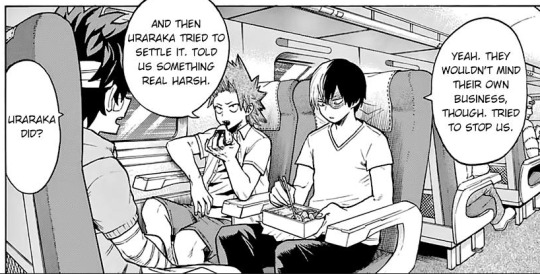

While she’s not wrong, what the hell kind of line is that? Thoughout the whole discussion, listening to the class go back and forth about whether or not to do something about Bakugou, Uraraka offers only one, very minor line pointing out their numbers. It’s not until afterward that Uraraka has anything to say. But what sort of heroine says this? What kind of hero says this?? It goes so strongly against the mold for heroes that it honestly surprises me - Uraraka does not strike me as a girl to tuck her tail and flee. I almost expect a girl in love to want to follow her crush anywhere, as I would expect from a usual shonen romance.
Were she the traitor, it makes a lot of sense that she wouldn’t want to be around the villains in an attempt to rescue Bakugou. If she’s not a traitor, she must have a serious beef with Bakugou to try to use the claim that saving him would just upset him. It’s just… unhero-like, and all around strange. It also bothers me that Uraraka was unable to say this line until after they Midoriya’s hospital room. It’s as though she could only think of it after that point or she didn’t want Midoriya to hear her say it.
After saving Bakugou and playing "King of All Room," Asui apologizes for what she said before saving Bakugou:

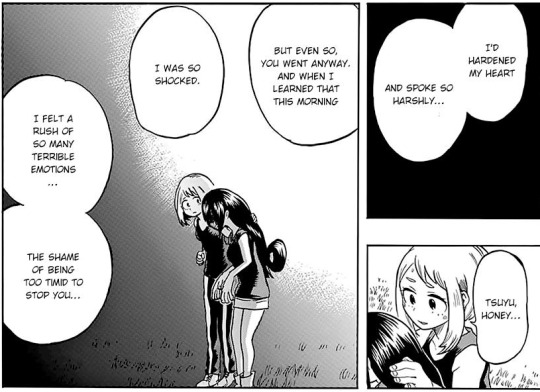
This whole scene with Uraraka is just weird. I’ll start with mentioning that Uraraka expresses no remorse for not going to save Bakugou - nor do we receive any indication of how Uraraka feels regarding the situation. Even if she didn’t want to risk saving Bakugou, shouldn’t she have risked going to make sure Midoriya would be okay? I mean, that’s basically why Iida went; shouldn’t the heroine and love interest of the story want to go just to protect Midoriya? At the very least, I would have expected a little soliloquy explaining her position to the reader. Similarly, Kirishima mentions that what Uraraka said was "really harsh," so I think it’s weird that when scene finishes that only Asui has apologized - I would almost expect Uraraka to want to join in on the apology so Asui feels better, but like clearly not. Uraraka either is the traitor or she has a serious beef with Bakugou.
By extension, what she does eventually say, weirdly enough, rubs me the wrong way. I would LOVE to see more translations of this scene, even just to look at the Japanese, because the way this is handled is so weird???? Why is she hesitating so apparently? What on earth does she have to be nervous about in this situation?! It’s WEIRD!!! But perhaps that’s just a personal feeling, you can be the judge of this dialogue yourself:

Short wrap-up
That should be like 90% of everything I’ve ever considered related to the traitor theory regarding Uraraka specifically. Just a few final notes to close the argument:
- I am not trying to imply that Uraraka is an evil character. MHA is absolutely dealing with the gray areas of what is good and evil, a theme that has been mentioned in several places in the series, from different perspectives and in different ways. The immediate moments we figure a traitor has to have been involve are (debatably) when the "reporters" break into school grounds as a guise for the villains, during summer break where someone leaks the location, and in the most recent chapter where Overhaul already knows about the infiltration. All of these likely had nothing to do with real “dirty work,” and rather were just information sharing
- One post-script update to my previous post regarding Uraraka is Bakugou’s “heel”. First is that the better, less presumptuous term for their relationship is “foils” - however, that gets convoluted due to the fact that in canon Bakugou and Midoriya are also called “foils.” Either way, both terms are acceptable. Recent omake information has revealed that Bakugou and Uraraka’s costumes are actually made by the same company. Translation here In short, the two black dots on each of their uniforms is supposed to be the company’s way of “branding” their material. It’s just backup omake information, but I think it’s just a cute detail to add and support my earlier argument regarding them.
- Food for thought: I’m still not sure when Uraraka becomes “the traitor.” My initial belief is she must have been a traitor since the beginning in order for the reporter incident to make sense, but it’s not necessary that she was. My other theory is that she joins the league after her crushing defeat against Bakugou. It’s also entirely possible that she isn’t the only traitor in the series; while I can’t think of any suggestions that might make this apparent, Uraraka had to have been contacted some how by the villains. The only thing I could say for certain is that if she is the traitor, she would have made her contract before her feelings for Midoriya became an issue.
- More food for thought: If Uraraka is the traitor, do Toga and Uraraka know each other? And was the encounter in the woods with Asui intentional? If I’m honest, I think Toga knows who Uraraka is, but because Uraraka has been away from "HQ" for so long, she never had the chance to meet Toga. Something about their encounter in the forest feels too real for it to be an act.
If you read the theory and like it, please reblog! If you have more questions, or want to add onto it, feel free to respond. This is just a theory after all, so I really hope that even if you don’t agree she’s the traitor, you may have found that I’ve made a few good points about the peculiarities of Uraraka’s storyline, and are just as excited as me to see how she develops.
EDIT: If you want to read more observations about her character related to this theory, I have a Traitor Uraraka tag you can look through!
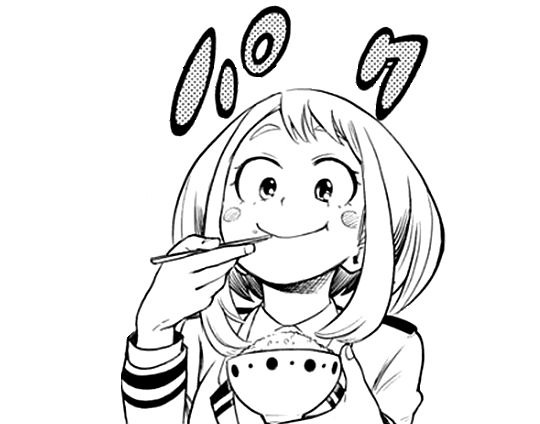
#my hero academia#uraraka ochako#midoriya izuku#bakugou katsuki#dekuura#yaoyorozu momo#toga himiko#asui tsuyu#camie#shigaraki tomura#overhaul#hero killer stain#mha#me#by me#traitor uraraka
5K notes
·
View notes
Photo

School's in Session - Classes in Starfinder
---
One of the best parts of cracking open a new RPG is learning about our options for character selection. What can we BE?! Many of the tabletop systems set in high-fantasy settings include a similar assortment of the four iconic class choices - wizard, fighter, cleric, rogue. With the Core Rules of Starfinder, we follow in the same footsteps, albeit in a science-fantasy setting. As such, the class concepts overlap with their fantasy counterparts, but obviously with reskinning for the interstellar setting. Let's run through the classes as written in the Core Rulebook, and then highlight the key differences and tasty space-flavor that set them apart from the Pathfinder classes. I'll go ahead and link each class to a representative Star Wars character who would fit in that mold as well.
Envoy: “Charismatic people person good at a wide range of skills who inspires allies to accomplish great heroic feats.”
Similar to: Bard
Persona: Senator Leia Organa/Emperor Palpatine
Thoughts: Being charisma-based, the Envoy could be considered as the 'sweet-talker' class, or the class that handles negotiations and diplomacy. They also make terrific improv comics. As we are in universe with alien races and countless languages, it is important for the Envoy to possess the ability to communicate in a variety of tongues, or at least be exceptionally fluent in a single language. A key difference from the bard is that the Envoy isn't carrying around a lute as she traipses across the galaxies. One could say that her voice is her instrument, and her words can bolster allies in a support capacity.
Mechanic: “Master of machines and technology whose tinkering produces a drone companion or a powerful brain implant.”
Similar to: Ranger
Persona: Young Anakin Skywalker
Thoughts: The main similarities that the Mechanic has to the ranger class are the typically ranged fighting styles and the ability to have a companion. Now, a Mechanic's companion will be fed with oil as opposed to carbon-based foods, but the concept is the same. In a way, the implant route is reflective of rangers focusing on a more arcane-based path, since technology is a pseudo-replacement for magic in the Starfinder universe. Magic exists on its own, as we will see with the Mystic, but it goes hand-in-hand with technology to create an almost symbiotic relationship. Mechanics place emphasis on programming and technical know-how to enhance their abilities, equipment, and ships. I'm looking forward to additional implants in the future to create some Inspector Gadgets of my own.
Mystic: “Magic user whose mysterious connection to a powerful force grants abilities that break the laws of the universe.”
Similar to: Wizard/Cleric
Persona: Obi-Wan Kenobi
Thoughts: Space Wizards! The Mystic is the primary magic class in Starfinder, using connections with otherworldly forces as the conduit to their powers. There's a note in the Core Rulebook that mentions Mystics often being tied to specific deities, so there is a definite similarity to clerics and wizards. Mystics have access to an extensive list of spells, going all the way up to 6th level (lower than Pathfinder caps). Just like magic users in fantasy settings, Mystics should carry some wort of melee weapon or pistol to protect themselves when the magic wells have run dry. Players looking to get their hands on a Jedi-imitation will come flocking to the Mystic to max out their midichlorian-levels. I mean, 'FORCE' is right in the description!
Operative: “Stealthy combatant with wide-ranging know-how who is adept at taking advantage of unprepared foes.”
Similar to: Rogue
Persona: Boba Fett/Han Solo
Thoughts: As a skill-heavy jack-of-all-trades, the Operative was made to infiltrate and eliminate targets, just like rogues would stick to the shadows and get that sweet, sweet sneak-attack damage. Oftentimes rogues would be plucked from the seedy bars or back alleys of Golarion and were characters who reveled in their individuality and solitary nature. The Operative is described as putting their objective before everything else. Objective, self, everything else. Obviously, there are a bunch of directions that players can go with this in terms of background - assassin, smuggler, informant, thief, bounty hunter, etc. Operatives excel at precision damage, scouting, and stealth, and have some shades of Gunslinger as they progress in level.
Solarian: “Disciplined warrior whose mastery of the stars grants either a weapon or armor made of stellar power.”
Similar to: Paladin(?)
Persona: Yoda
Thoughts: Okay, I know that the persona doesn't really fit very well for this one. Lightsaber and highly-disciplined are the two traits that I'm working off here. Solarian is arguably the most unique class that doesn't necessarily translate directly to a base Pathfinder class. Harnessing the powers of photosynthesis, a Solarian can conjure armor or a weapon to use in battle. Further individualization is granted by the photon and graviton modes which represent the duality of star power (attraction and emissions). I love the imagery of a Vex rumbling around a corner completely decked out in a dazzling suit of stellar armor. Solarians are similar to Paladins in the sense that there is a certain yin and yang between the Paladin and the Antipaladin that is reflected in two routes of the Solarian. While a graviton-centric Solarian isn't the embodiment of evil, like an Antipaladin would typically be, you still have these two sides of a coin that can be taken in interesting roleplay directions. Keep in mind that Themes will usually have a greater effect on backstory than class will (not always).
Soldier: “Expert with a huge range of armor, guns, and melee weapons who specializes in certain types of gear.”
Similar to: Fighter
Persona: General Grievous/Chewbacca
Thoughts: You knew it was coming, the stereotypical 'bash faces' class. The Soldier fits that bill and does SO much more. Due to the sheer volume of weapons available in the Starfinder universe, each Soldier has more creative wiggle room than the Fighter had in Pathfinder. Combat feats, gear boosts, and (especially) access to arcane magic imply that this system has space for a dual-wielding battle mage AND a heavily-armored mobile fortress. As with all fighter-esque classes, gifting your character quirks and mannerisms will go a long way in defining your character as more than just a 'walking gun'.
Technomancer: “Magic user who is preternaturally attuned to technology and can use it to unlock powerful effects.”
Similar to: Druid/Sorcerer
Persona: Rey
Thoughts: Correlating the Technomancer to a Pathfinder class also wasn't instinctively intuitive, but Druid is a close fit. While druids were the embodiment of nature and magic, Technomancers more closely resemble the union of technology and magic. I see them as a Mechanic on steroids, and they remind me of a character who has just discovered their magical powers by accident but who doesn't know how to control them. Their seemingly innate arcane talents also have a hint of Pathfinder's sorcerer class because the power of a sorcerer came from within and was not a product of intense study. Technomancers splice magical energies as if they were brewing potions, taking a strand from here and a pinch from there to create their own interpretation of the world around them. Daft Punk would make a great Technomancer duo.
---
There you have it, the entire list of core Starfinder classes. You'll have to work with me on the personas because my Star Wars knowledge is relatively average, but I wanted to use another intergalactic intellectual property to get you thinking about the possibilities waiting to be unlocked with each class. Try pairing classes with themes that seem to be polar opposites and I'm sure you'll come up with some really unique character concepts.
*Bolded class descriptions verbatim from Paizo’s Starfinder Core Rulebook.
98 notes
·
View notes
Note
Sorry if this is a little uncomfortable, but given your opinions on fanservice and hentai with underage characters, I'd like to know your opinion on cosplayers/burlesque performers who dress as sexy versions of such characters. Being that it's more a costume and less a portrayal, would that be problematic?
Nah, it’s cool. c:Anyhoo, this is a tightrope well worth walking. I guess one of my immediate thoughts is that a person choosing to dress a certain way is inherently waaay less problematic than a character designed to be sexy because the person has agency and the fictitious character by definition doesn’t have: anything and everything about a fictitious was a choice by the writer/artist/designer/etc. I also think that portrayal is an integral (if not indispensable) part of cos(tume)play, but unless the person is out for age play (ew, fucking no) then their real age still governs. To be honest, aside from that cringy possibility, the main focus shouldn’t be (and usually isn’t) age anyway (Edward Elric would have a Napoleonic complex whether he was 15 or 50, Dilandau Albatou would be a giggling cheek-obsessed maniac at 15 or 50, Katsuki Bakugo would still shriek about wanting to kill his friends and loved ones at 15 or 50, etc.). So right there I tend to think it’s less problematic, but I feel like I’m dancing around the issue.So here’s the real issue as I see it. The overwhelming majority of female characters (regardless of age) in anime, video games, comics/graphic novels/manga/etc. are designed primarily to be sexy (or at least designed with being sexy as a major goal), to the point that there are some really fucking idiotic plot contrivances that are just expected at this point. Flying superheroes wear miniskirts, armor has boob plate and boob window, veteran dragon knights ride their mounts in bikini bottoms, combat miniskirts and stiletto heels exist, etc. etc. etc. I could probably max out the word count just listing that shit, but instead I respectfully refer you to bikini armor battle damage’s tumblr (they do a much better job explaining and eviscerating this shit than I could). Here’s the thing, though:IT IS NOT YOUR JOB TO RIGHT THE WRONGS OF PERVERTED IDIOT WRITERS AND ARTISTS.Off the top of my head, I like Momo Yaoyorozu because it would’ve been so easy to make her into a stereotypical rich bitch or waifu character, and instead she actually comes off more like a 3-dimensional character … unfortunately she’s also the second-string fanservice character (after Midnight). Meaning, well, have you seen her superhero outfit? Have you? Have you seen the fucking modified sling bikini she wears into battle (along with heels, because of fucking course high heels are the best possible footwear for running on uneven terrain)? If somebody wanted to faithfully cosplay her superhero outfit (and not do an AU version, I mean), then they’d have to let it all hang out. (The same thing would go for Eijiro Kirishima, incidentally, but that’s far closer to idealization than objectification, so instead a better example off the top of my head is basically every female character in the entire Soul Caliber franchise.) In this case, the person is under no obligation to tone down the sexiness that the creator forced upon the character.So here’s the spin-off issue. Obviously sometimes the character design becomes more sexy if the cosplayer is older. Speaking from personal experience, I didn’t realize that Misty’s original outfit is basically a half shirt and short shorts until this woman I had a crush on in college cosplayed as her. This issue is, of course … not an issue. Really, the only thing I can think of is: DO NOT BE ASHAMED OF YOUR BODY OR SEXUALITY. PLEASE DO NOT. YOUR BODY EXISTS FOR YOUR OWN PURPOSES, NOT TO CONFORM TO OTHERS’ STANDARDS.Imma be blunt: shitting on someone for how their faithful cosplay looks because of how their body alters it (based on height, weight, curves, skin color, physical disability, etc.) is bodyshaming. It is bullying a person based on their body’s unique characteristics. Not much else to say on that, other than there’s just no need for that. Ever.And then, of course, is the other spin-off issue. Obviously there are some cosplayers that add extra sexy. As to that … I’m more ambiguous. I can immediately think of some pokemon cosplays (and I mean cosplayers cosplaying pokemon) that have far more visible tiddie than I recall from the tcg, video games, anime, or (to a lesser extent) manga. Any time someone starts introducing that stuff to a franchise aimed at kids, they need to be careful lest they turn into their fandom’s equivalent of My Little Pony: FiM’s cloppers. By the same token, I guess the “injected sexy” cosplay can depend heavily on the source and the fandom. Going back to Soul Caliber, it doesn’t seem that out of place for someone to do a “day at the beach” style (read: bikini) Ivy … as opposed to, say, a dominatrix Nurse Joy. (And before anyone brings up that pedotastic pokemon manga, I’m not touching cultural dissonance here, just western cosplay.) Of course, it’s not so ironclad; Steven Universe arguably lends itself far more readily to overtly sexual fanworks (not an insult) than MLP:FiM, but a kid can still google it without being bombarded with images of Pearl going down on … well, you know. At the same time, it’s kind of demeaning and can send a very unfortunate message (that a character’s identity, personality, and uniqueness aren’t as important as their looks), and that’s not even getting into the frankly repulsive issues surrounding re-enacting “accident groping” and the like (cosplay obviously isn’t consent, but that really blurs things and can, you know, fucking trigger a sexual assault survivor like me because “hur hur that happens to the character all the time uwu). Injected sexy can push things down an unfortunate path, and sexualizing a child is bad enough when it’s the creator doing it.And so, in conclusion, I see 3 types of sexy in cosplaying.Sexy by Creator Fiat … is not problematic.Sexy by Cosplayer’s Body … is probably the least problematic.Sexy by Injection … can be problematic but isn’t necessarily an issue depending on stuff like the medium and the target demographic.At its core, 99% of cosplay just isn’t problematic, or at least doesn’t gain any new problematic elements beyond those already present in the anime or whatever (though there can be more than enough problematic shit being inherited from the medium). A lot of times, though, it says more about the people who are raging at someone’s creativity, passion, and (admittedly) body and sexuality than it does about the cosplayer. (Just please don’t fucking do gag molestation or sexual assault, I’d rather not have to worry about getting a panic attack when I’m trying to look up cosplay.)And here’s a final thought for you: I *have* done “sexy cosplay“ and am looking to do it again. It’s just that my sexy cosplay focuses on confident and visually striking characters (Reigen Arataka, All for One, Young Joseph Joestar) which in turn makes me feel confident and sexy. (That’s not a dig on cosplayers that favor characters with more revealing outfits, just personal preference. Hopefully this makes sense!!!) However, you might have noticed that, with one possible exception, all of those characters are “covered up” (hell, they all wear fucking suits or the like most of the time) … so is it possible that at least some of the complaints about cosplay being problematic are just the latest version of the old misogynistic “cover up” body policing? ;)Hopefully that makes sense. This was kind of a rush job.EDIT: Fleshed it out, talked about my own cosplay experiences.EDIT2: Looked up some cosplay, nearly had a panic attack because two "enthusiastically consenting” cosplayers were reenacting nonconsensual groping scenes, got salty and has to comment.
0 notes